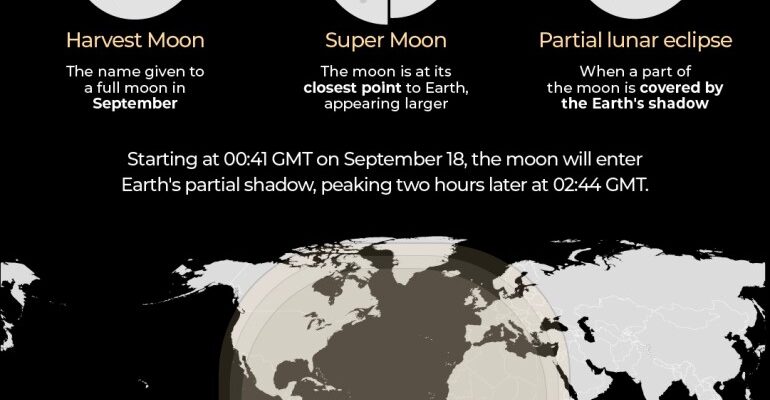The celestial stage was perfectly set in September 2025, as a full Moon, affectionately known as the “Corn Moon,” treated stargazers across Russia to a breathtaking spectacle: a total lunar eclipse. From the vast expanses of the Far East to the bustling heart of Moscow, millions gazed upwards as our familiar lunar companion underwent a dramatic transformation, briefly donning an ethereal cloak of orange and crimson. This wasn`t merely a visual treat; it was a profound demonstration of atmospheric physics, turning our quiet neighbor into a radiant “Blood Moon.”
A Pan-Russian Spectacle
On the evening of September 7th and extending into the early hours of the 8th, the full September Moon rose over Eurasia, already imbued with a subtle golden hue. But as the Earth positioned itself directly between the Sun and the Moon, a profound change began. Reports flooded in from every corner of Russia – from the ancient peaks of the Urals and the rugged beauty of the North Caucasus, through the sprawling cities of Siberia and Moscow, to the serene landscapes of Crimea and the distant Far East. Each location offered a unique vantage point to observe the slow, deliberate progression of the eclipse.
For observers, the anticipation was palpable. The eclipse commenced at approximately 19:26 Moscow Standard Time (MSK), with the Moon gradually entering the Earth`s penumbral shadow. The real magic, however, unfolded an hour later. By 20:31 MSK, the Moon was fully immersed in the Earth`s umbral shadow, where it began to glow with a deep, unmistakable red. This crimson phase held the audience captive until 21:53 MSK, as the Moon slowly started its exit, eventually returning to its customary silvery brilliance around 22:56 MSK. A relatively swift celestial dance, yet one that left a lasting impression.
The Science Behind the Crimson Glow
The sight of a “Blood Moon” might evoke ancient superstitions or dramatic folklore, but the phenomenon is entirely, exquisitely scientific. As explained by Dr. Sergey Yazev, Director of the Astronomical Laboratory at Irkutsk State University, the captivating reddish tint is a direct consequence of Earth`s atmosphere acting as a colossal, albeit imperfect, lens.
When sunlight travels towards Earth, our atmosphere selectively scatters shorter, bluer wavelengths of light – this is why our sky appears blue during the day. However, longer, redder wavelengths are less prone to scattering and can penetrate further through the atmosphere. During a total lunar eclipse, the Sun`s light must pass through a significant portion of Earth`s atmosphere before it reaches the Moon, which is now entirely within Earth`s shadow.
“Solar light, passing through Earth`s atmosphere, is deflected and enters the Earth`s shadow cone, subtly illuminating the Moon,” noted Dr. Yazev. “The blue part of the spectrum scatters in Earth`s air, but the red light passes through, albeit refracting. As a result, the Moon in Earth`s shadow appears reddish – sometimes almost crimson.”
So, while the Moon is technically in shadow, it`s not entirely dark. Instead, it`s bathed in all the sunrises and sunsets happening around the Earth`s limb at that moment, casting a dramatic, ruddy glow upon its surface. It`s a cosmic trick of the light, transforming a shadow into a canvas of vibrant color. One could almost feel a sense of irony: humanity`s atmosphere, so often taken for granted, performing its most stunning optical illusion on a distant world.
The “Corn Moon” and Its Legacy
The September full Moon carries the evocative name “Corn Moon,” a tradition rooted in the agricultural cycles and cultural practices of indigenous North American peoples and early farmers. It signifies the time when corn and other staple crops are harvested, a period of bounty and transition. This year, the Corn Moon`s radiant orange glow before the eclipse served as a poignant reminder of this historical connection to nature`s rhythms, adding another layer of depth to the celestial event. It`s a delightful convergence of human history and cosmic mechanics, reminding us that even in our technologically advanced age, the cycles of the sky still resonate deeply.
Conclusion: A Shared Glimpse of the Cosmos
The total lunar eclipse of September 2025 was more than just an astronomical occurrence; it was a unifying experience. Across a nation spanning eleven time zones, people paused, looked up, and shared a moment of wonder. Such events serve as potent reminders of our place in the universe, the intricate dance of celestial bodies, and the profound, yet often subtle, scientific processes that govern our world and beyond. While the “Blood Moon” may have retreated, its crimson memory lingers, a testament to the enduring power and beauty of the night sky.







